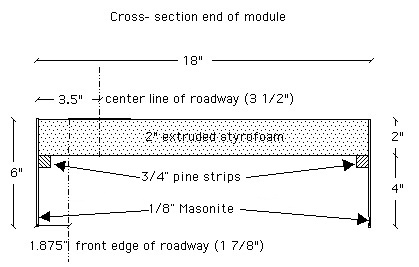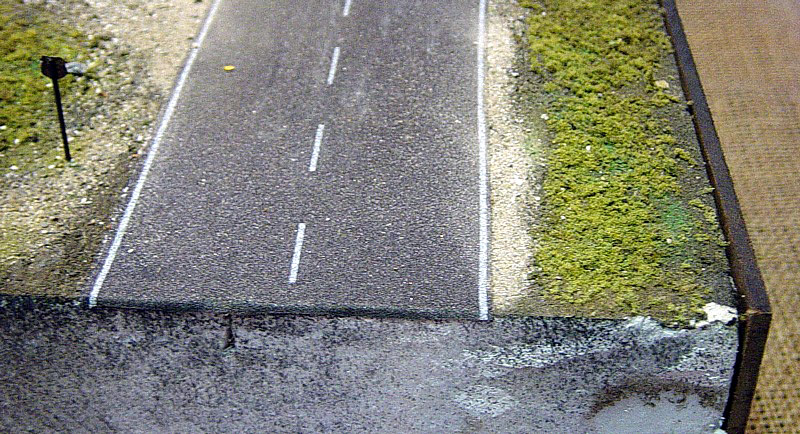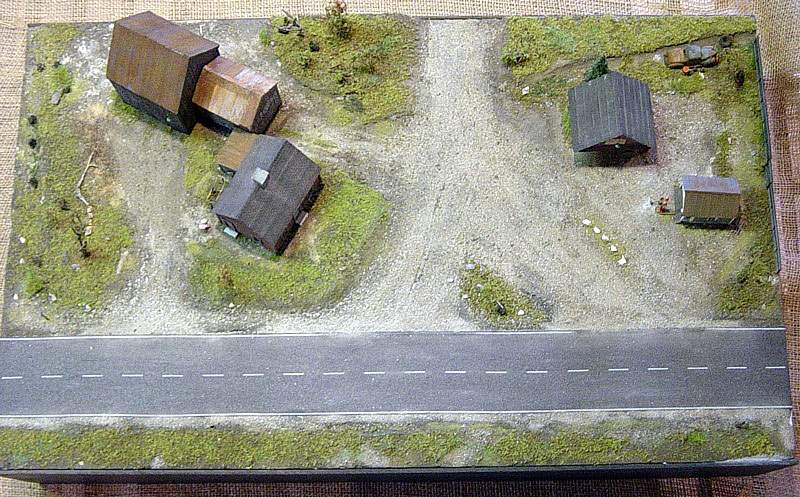 Route87 Basics - Module Construction by Chester Fesmire
Route87 Basics - Module Construction by Chester Fesmire
You may recognize the photo above as one of the first Route87 modules publicly displayed at the 2010 East Coast Meet in W.Springfield, MA, January 30-31, 2010. The module was built by Chester Fesmire and he's agreed to share some of his basic building techniques using the Route87 standards. We thank Chester for sharing his building tips! The 2010 Springfield show saw the first of the Route 87 modular dioramas on public display. And although the numbers of modules were small, they provided a great deal of interest and showed many just how well our vehicles are validated in a realistic setting.  © Drawing courtesy of Chester Fesmire We start with the module standards for the basic Route87 module. These dimensions should be strictly adhered to so that interconnection of modules is possible for public display, the main purpose of the standards. This basic module is the first of what we anticipate will be several standard configurations governing different types and styles of roadways. This first basic standard is for two lane, paved (asphalt) roadway configuration. Please refer to the Route87 web site for the latest updated standards. The basic construction materials needed for building the standard module are: I believe we have come upon a good set of standards for the modular display and would like to briefly review them and try to give some recommendations on how to best construct them. The dimensions we have all agreed on are 6 inches in height, 18 inches in depth and widths from 24 inches to 48 inches (typically; can be shorter or longer with transport considerations being the determining factor in most cases). The Busch roadway (Busch # 9710) offers a good two lane highway that we have established a 3-1/2 inch distance to the centerline from the front of the module for its location. This allows for a lot of usable space behind the road to present additional vehicles, structures, figures and scenery. For materials, the base used is 2 inch extruded styrofoam and the only requirement is that the roadway portion meet at precisely at the 6" height and be the determined 3 1/2" from the front so each module's roadway meet evenly with any accompanying modules. Aside from these dimensions, the styrofoam may have changes in elevations elsewhere throughout the module. The next critical material is the front and back platforms that hold the module up. 1/8th inch Masonite is used for this and in the sample module I made for the 2010 Springfield show, I sprayed the exposed faces with satin black enamel (highly recommended, likely to become part of the standard. Raw Masonite takes wood glue very well and to support the 2 inch styrofoam, I simply glued a strip of 3/4" x 3" pine to the inside, 2 inches down from the top of the Masonite. To affix the styrofoam and hold the front and back to the styrofoam, I used a latex adhesive caulking. There is caulking available exclusively for use on extruded styrofoam also. Be advised that some of the construction adhesive caulks (Liquid Nails, PL 400 etc.) are not conducive to use with the styrofoam and will deteriorate the styrofoam, so stick with a latex based adhesive product. This literally holds the whole unit together.
In creating my diorama, which is 30 inches in length, I located the roadway first and masked it's exact location on the styrofoam with masking tape. This allows for a clean surface on which the Busch adhesive backed roadway will later stick while working on the rest of the diorama. I did my scenery and ground cover, then removed the tape and placed the self-adhesive roadway material in this manner. Some minor blending of ground cover to the road surface adds to it's realism if so desired. Anything can happen between the ends of the module in terms of elevation, road direction and/or condition as long as the road material meets at the proper location (offset from front edge) as it enters and exits the diorama.
In my module, I created an intersection with a gravel road (shown above) but things like road construction, alternating direction, bridges etc. are all possible between the two exiting points. Going much beyond this quick "how-to" would be a lesson in structure building and scenery but I'll leave that all to the creativity of any and all who decide to participate. I have provided a sketch of the end view of the module. This technique allows for a sturdy, light weight module that is easily transported and links well to adjoining dioramas. Thanks to Chester for this quick tutorial and to everyone involved in the Route87 module standards project. Refer to the Photo Gallery Search Index for photos of Route87 modules. If you have any comments or questions please refer to the Route87 web site or contact us. We are really looking forward to nurturing this concept and seeing just how creative all of you can be. If you have any comments or questions please refer to the Route87 web site or contact us. [posted 03/11/2010] |
||




